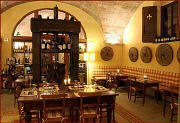Eating Well in Italy With the Help of Two Great Books
 Anyone who’s traveled to Italy and been able to get off the beaten path has likely experienced some of the food bliss that keeps people talking about (and returning to) the country which has given us so much to be blissful about. Whenever people ask me how to find the best meals on their next trip to Italy, my advice always begins and ends with the same thing – find the places where the menu is only in Italian.
Anyone who’s traveled to Italy and been able to get off the beaten path has likely experienced some of the food bliss that keeps people talking about (and returning to) the country which has given us so much to be blissful about. Whenever people ask me how to find the best meals on their next trip to Italy, my advice always begins and ends with the same thing – find the places where the menu is only in Italian.
When a restaurant is in a tourist-filled city, it only makes sense that they’d have a multi-lingual menu to help their guests know what they’re ordering and enjoy what’s put in front of them. I agree that this seems logical, but it’s also the best way to avoid Italy’s best food. The #1 way to eat forgettable meals and leave Italy wondering what all the food-fuss is about is to stick to restaurants with a familiar language on the menu.
So, since not everyone speaks Italian, how can you order a meal like the savvy traveler you are, if the menu is all in Italian and you’re fortunate enough to be far enough from a tourist center that the waiter doesn’t speak English? You’ll be well-equipped to handle this situation if you’ve armed yourself with a couple of excellent guides before you left home.
First is my food Bible when I travel to Italy – The Hungry Traveler: Italy. I can’t even count the number of people I’ve recommended this book to, and I continue to think it’s the best way to make sure you not only have a handle on what you’re ordering but that you order what’s fresh and local – no matter where you are in Italy. It’s a tiny little thing, so it easily fits in a purse (even a travel purse!) or possibly even your back pocket, and it’s positively indispensable.
Second is a new book put out by the fantastic Slow Food people, called Osterie & Locande d’Italia, or “Osterias and Locandas of Italy,” which is a lengthy list of Italy’s more informal and traditional eateries (more here). It covers the entire country and mentions more than 2,000 places to both eat and stay throughout Italy. What makes places like the ones covered in the book (and many that aren’t) so special is that they tend to be small, family-run places which are frequented by locals. You may be the only outsider in some of these places, but that’s part of the fun of travel (at least it is to many people).
With these two books at your disposal, you’ll be able to confidently wander away from the multi-lingual menus no matter where you are in Italy – and you’ll no doubt have some of the best meals of your life because of it.
Buon appetito!